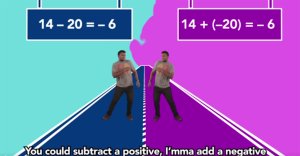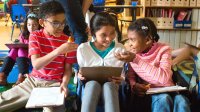Ditching the Math Textbook
Using music and seeking out math in the real world are two options to pursue when you set aside your textbook.
Your content has been saved!
Go to My Saved Content.Many students enter the classroom with a notion that mathematics is simply pencil-and-paper calculations, unconnected to their lives. And many of them have a negative mindset about their math abilities.
Because of these misconceptions, teachers must model thinking outside the box and show students that there are many ways to come up with a solution. Risk taking should also be modeled. It’s of great importance that students realize that mistakes can have a positive impact on learning. I tell my students, “You have to make mistakes to learn!” When students are willing to take chances knowing that failure is a possibility, creativity can emerge.
Ditching the textbook, even occasionally, is a great way to enhance creativity in math, opening up space for real-world problems and for incorporating technology and music into lessons. I’ve learned through the years that students don’t always learn best through teaching in a chapter format. The textbook can be a supplemental resource instead of the primary one.
Music education is trending as a means of assisting students in learning and retaining information. Children learn the structure of math even before they can understand and properly convey its vocabulary and symbols, and they’re able to integrate math and music by making comparisons, patterning, and sequencing.
Ditch the Textbook—Gradually
As Matt Miller says in Ditch That Textbook, “Ditching your textbooks means looking for different, innovative, tech-laden, creative, and hands-on ways of teaching.” His advice: “Don’t try to do it all at once. Pick one or two ideas that really light your fire and pursue them. Starting with any more than that is often overwhelming.” Pick a few concepts or skills from the textbook to focus on using alternate resources.
This nontraditional way of learning can be as easy as doing a geometric scavenger hunt: Take students outside and give them a list of geometric shapes as well as figures such as parallel, perpendicular, and intersecting lines. As they search for the items on the list, they’ll realize that math is all around them. Having them take photos of these shapes using their iPads or phones is also a way to engage them in their learning, and it allows the teacher to quickly assess student understanding of geometric vocabulary.
Another way to ditch the textbook is to apply story problems to real-life situations. This can be as easy as bringing in menus from different restaurants. The students can work together to place orders and then calculate costs and, when they pay, how much change they should receive. This makes students less reliant on a book and more aware of the learning that takes place through everyday interactions.
Infusing technology into lessons can also have a major impact on student learning. Many math apps motivate students to extend their learning outside the classroom. You know you’re reaching students when they spend their free time competing with their classmates to master content standards in Splash Math. Another app that has extended my students’ thinking is Prodigy, a game-based app that motivates students to take control of their learning. It allows them to challenge themselves at their own pace.
Implementing more hands-on activities has sparked creativity within my classroom. It has motivated my students to learn in a different manner than they’re accustomed to. Students thrive on anything that’s outside the norm—when they realize the textbook is being put aside, they feel free to explore.
The Power of Music
Infusing music into a math lesson can have a major impact on student learning and understanding. What better way to catch students’ attention than by incorporating their love of music? Take the musical Hamilton, for example. Teaching children about history through music and song has encouraged them to look at our nation’s past in a whole new light. Using music as a way to engage students is an effective way to enhance their learning and their ability to retain and recall information.
Flocabulary is one way to incorporate music in math class. Think of it as “Schoolhouse Rock” with an edge. It’s a learning program for all ages that uses educational hip-hop mixed with creative videos. Some of the raps include standards about basic facts, number sense, geometry, and algebra.

Flocabulary covers many math content standards. For example, order of operations is a difficult concept for many students, and there’s a PEMDAS rap to make it easier to understand. The key to learning is making it a memorable experience, and Flocabulary does this. Not only can students listen, watch videos, and complete lessons, but there’s also an aspect of creation. In Lyrics Lab, students are able to write and perform their own academic raps. Students can pick a beat to weave into their mathematical content.
This is a valuable tool to show learning and understanding, and it allows them to take ownership over their learning. As we all know, when students can make a connection with the concepts and skills being taught in class, they become invested in their academics.
